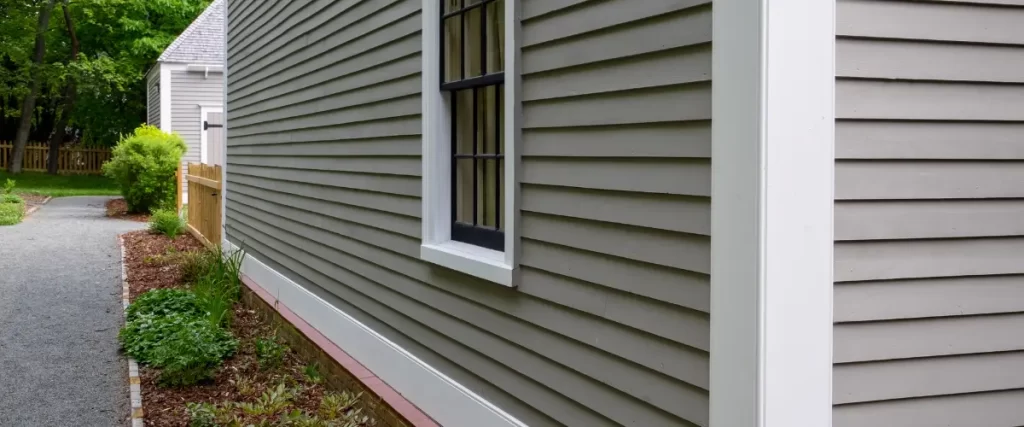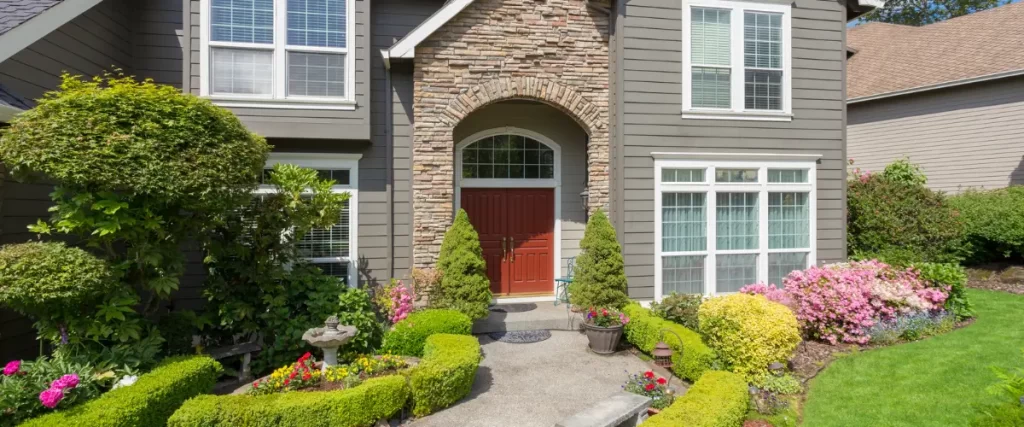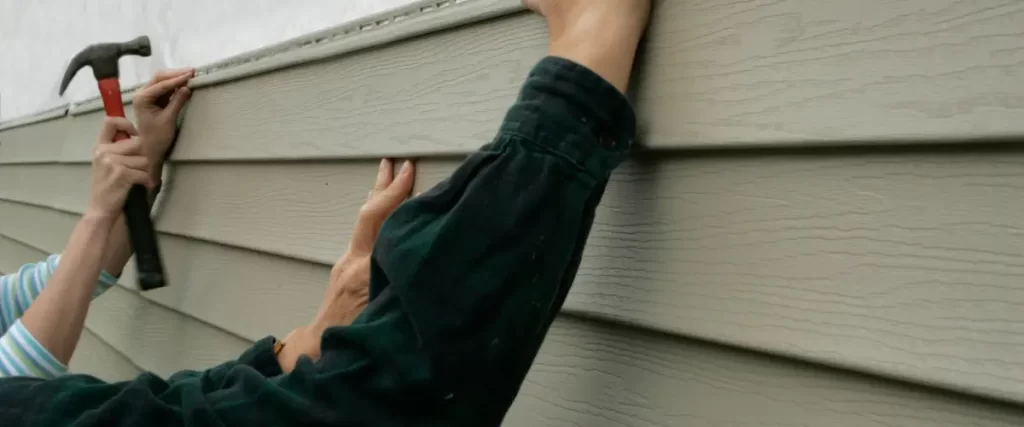Choosing between fiber cement and vinyl siding is tough for many homeowners. Fiber cement siding is known for its durability and aesthetic flexibility. This post will compare key differences, including cost and maintenance, to help you decide.
Keep reading to find out more.
Key Takeaways
- Fiber cement siding is more durable and fire-resistant but costs more initially and needs more maintenance.
- Vinyl siding is cheaper, requires less care, and is easier to install but isn’t as long-lasting or fire-resistant.
- While fiber cement can last 50 years with upkeep, vinyl offers a cost-effective solution with lower maintenance.

Key Differences Between Fiber Cement and Vinyl Siding
Fiber cement siding offers high durability but requires more maintenance and has a higher initial cost compared to vinyl siding. On the other hand, vinyl siding is more affordable, low-maintenance, and easier to install than fiber cement.
Durability
Fiber cement siding is very durable. It is made from Portland cement, wood pulp, and silica sand. This mix gives it the strength to resist moisture damage, severe weather, and fire. It can last up to 50 years with proper maintenance.
Vinyl siding is made of polyvinyl chloride (PVC). It stands up well to extreme temperatures but can crack or melt in extreme heat. Unlike fiber cement, vinyl may need more repairs over time.
Maintenance Needs
Fiber cement siding needs some upkeep to stay in good shape. You must paint or stain it every 15 to 20 years. To clean, use a garden hose and a soft brush once a year. This keeps it looking fresh and protects against damage from dirt and weather.
Vinyl siding is easier to take care of than fiber cement. It doesn’t need painting or staining. A rinse with a garden hose now and then keeps it clean. This makes vinyl siding a low maintenance choice for homeowners.
Now, let’s talk about the cost of both options.
Cost
Maintaining your home’s exterior affects your budget. Choosing between fiber cement and vinyl siding is a big decision. Vinyl siding costs less at first. You might pay around $1 to $2 per square foot for standard vinyl siding.
For insulated vinyl siding, the price goes up a bit.
Fiber cement siding, like Hardie Board or cement board siding, can be more expensive. Installing fiber cement siding might cost you about $6 to $11 per square foot. The higher cost comes from the material itself and the labor because it’s heavier and needs special tools for installation.
But over time, fiber cement could save money due to fewer repairs needed and its long life span.
Energy Efficiency
When considering energy efficiency, fiber cement siding outperforms vinyl siding in terms of R-value. This indicates that it offers improved insulation for your home, reducing the requirement for excessive heating or cooling.
Furthermore, fiber cement is crafted from sustainable materials such as wood fibers and fly ash, establishing it as an environmentally friendly option that aids in reducing the environmental impact of your home.
Pros of Fiber Cement Siding
Fiber cement siding offers fire resistance, a long lifespan, and the flexibility to achieve various aesthetics. Learn more about these advantages by reading our blog!
Fire Resistance
Fiber cement siding is fire-resistant, a major advantage especially in areas prone to wildfires. It’s made with cellulose fibers, which are resistant to fire. This means that it won’t catch fire easily, providing an added layer of protection for your home against potential fire hazards.
For homeowners concerned about fire safety, fiber cement siding offers peace of mind and can even help lower insurance premiums due to its fire-resistant properties.
Vinyl siding, on the other hand, has limited fire resistance compared to fiber cement. Vinyl can melt or burn when exposed to high heat or flame. Choosing fiber cement over vinyl could be crucial in safeguarding your home from potential fire damage and ensuring additional safety measures.
Long Lifespan
Considering the long lifespan of fiber cement siding, it stands out as a durable option for homeowners. Fiber cement siding is known to last for several decades with proper maintenance.
This longevity can provide peace of mind for homeowners, as they won’t need to worry about frequent replacements or repairs. Moreover, fiber cement siding is resistant to rot, pests, and harsh weather conditions, further contributing to its enduring nature in comparison to other types of sidings.
When it comes to long-term value and durability for their homes, many homeowners find that the extended lifespan of fiber cement siding makes it a reliable choice worth considering when making important decisions regarding home improvement.
Aesthetic Flexibility
Fiber cement siding offers homeowners a wide range of design options to enhance their homes’ exteriors. It can replicate the look of real wood, stucco, or even modern facades. With long boards and various colors available, homeowners can customize the appearance of their house to suit their style and preferences.
Whether they prefer a traditional or contemporary look, fiber cement siding provides an array of choices for creating a personalized and modern facade that enhances the overall appeal of their home.
Moreover, apart from its aesthetic adaptability, fiber cement also has eco-friendly benefits. It is crafted to improve energy efficiency by reducing heating and cooling costs, making it an attractive option for homeowners who seek both versatility and sustainability in their exterior cladding choice.
Cons of Fiber Cement Siding
Fiber cement siding has a higher initial cost and complex installation process. These factors may require careful consideration before making a decision.
Higher Initial Cost
Fiber cement siding has a higher initial cost compared to vinyl siding. This is due to the fact that the raw materials used in fiber cement, such as cement, sand, and wood fibers, are more expensive than the PVC resin used in vinyl siding.
The installation of fiber cement also requires specialized tools and techniques, which can add to the overall cost. Nevertheless, it’s crucial to consider that while the initial investment may be higher, fiber cement tends to have lower maintenance costs over its lifespan due to its durability and long-lasting nature.
Homeowners on a tight budget should weigh these factors before making a decision.
Moreover, according to accredited quality control agencies, the labor costs for installing fiber cement can be higher due to its heavier weight and complex installation process compared to vinyl siding.
Thus, homeowners considering these options should factor in the comprehensive cost of both materials along with their long-term benefits when making their decision.
Complex Installation
Fiber cement siding installation demands a lot of labor and specific tools. It must be installed with great care to avoid any damage. The heavy fiber cement boards make the installation process more challenging, often requiring multiple individuals to work together.
Moreover, cutting fiber cement siding generates silica dust, so proper protective measures should be taken during installation to ensure safety. It is generally advisable to seek professional expertise for an efficient and secure installation process.
By contrast, vinyl siding is lightweight compared to fiber cement, which allows for easier and quicker installation. The material is crafted for easy handling without extensive preparation or additional precautionary measures, thus resulting in a simpler and less labor-intensive installation process, saving time and money for homeowners seeking a hassle-free home improvement project.
– Fiber cement siding necessitates specialized equipment for cutting and installation.
– Vinyl siding’s lightweight nature makes it easier and faster to install.

Pros of Vinyl Siding
Vinyl siding is highly affordable, making it a cost-effective option for homeowners. Its low maintenance requirements save time and effort for busy homeowners.
Affordability
Vinyl siding is known for its affordability, making it a popular choice among homeowners on a budget. Compared to fiber cement, vinyl siding generally has lower initial costs, which can make it more accessible to many homeowners.
This cost-effectiveness extends to the installation process as well. With its lower purchase and installation expenses, vinyl siding provides an economical option for those looking to enhance their home’s exterior without breaking the bank.
When planning your home improvement project, keep in mind that vinyl siding offers affordability without compromising quality and durability. It stands as a practical choice for homeowners who seek cost-effective solutions without sacrificing performance or aesthetics.
Low Maintenance
Vinyl siding stands out for its ease of maintenance. It doesn’t require painting and is resistant to rot and insect damage. An occasional wash with mild soap and water is all that’s needed to keep it looking as good as new.
This convenience makes vinyl siding a popular choice for homeowners seeking a maintenance-free option.
In contrast, fiber cement siding, while durable, requires more maintenance than vinyl. It may need repainting every 5-10 years due to fading or chalking. It also requires routine inspections for cracks or gaps which can allow moisture in if left unchecked.
While both materials have their own advantages, the minimal maintenance required for vinyl siding makes it an appealing option for homeowners seeking lasting value without the ongoing maintenance demands.
Ease of Installation
Vinyl siding is recognized for its simple installation process. It’s light and can be put up swiftly, potentially reducing labor costs. Additionally, vinyl siding often comes with pre-drilled holes and can be directly installed over existing material, reducing the need for extensive preparation work.
This makes it a popular choice among homeowners seeking a straightforward installation process.
On the other hand, fiber cement siding demands more labor and expertise during installation due to its weight and specific handling requirements. The material also requires special tools for cutting because of its density and durability, adding intricacy to the installation process.
Therefore, in terms of installation convenience, vinyl siding emerges as a favorable option compared to fiber cement.
Cons of Vinyl Siding
Vinyl siding may have lower durability compared to fiber cement. Its limited fire resistance can be a concern for some homeowners.
Lower Durability
Vinyl siding has lower durability compared to fiber cement. Vinyl can crack, warp, or fade over time due to exposure to extreme temperatures and harsh weather conditions. It’s also susceptible to damage from impacts like hail or wind-blown debris.
Moreover, vinyl is not fire-resistant and can melt in intense heat.
The limitations of vinyl siding make it less durable in the long run when compared to fiber cement siding. This factor is crucial for homeowners looking for a low-maintenance and long-lasting exterior cladding solution – making fiber cement a better choice.
Limited Fire Resistance
Vinyl siding has limited fire resistance compared to fiber cement. This means it is more likely to melt or burn in a fire. It’s important for homeowners to be aware of this, especially if they live in areas prone to wildfires or want extra protection for their home.
Fiber cement, on the other hand, offers better fire resistance due to its composition of cement, sand, and cellulose fibers. This can provide homeowners with added peace of mind and may even lead to lower insurance premiums in some cases due to the reduced risk of fire damage.
FAQs
1. How does fiber cement compare to vinyl siding?
Fiber cement and vinyl siding are both popular choices for home exteriors. However, unlike vinyl siding which is made from fossil fuels, fiber cement is a more eco-friendly and durable material.
2. What makes Hardie board siding different from other siding materials?
Hardie board or fiber cement is known for its fire resistance and ability to absorb water, making it stand out among other options like stucco, wood, or aluminum siding.
3. Is insulated siding better than regular vinyl or fiber cement?
The “better” choice depends on several factors such as your need for energy efficiency and the R-value of the product – a measure of thermal resistance.
4. Can you tell me about the manufacturing process of both types of sidings?
Both vinyl and fiber cement undergo rigorous processes overseen by an accredited quality control agency. The final product in each case offers unique benefits.
5. Are there any environmental concerns with using these types of sidings?
While all materials have some impact on the environment, choosing eco-friendly options like fiber cement can help reduce reliance on fossil fuels used in producing traditional vinyl sidings.

Conclusion
In weighing fiber cement versus vinyl siding, homeowners should consider durability and maintenance needs. Fiber cement offers fire resistance and a longer lifespan, but comes with a higher initial cost and complex installation.
On the other hand, vinyl siding is affordable and easy to maintain, but lacks in durability and fire resistance. Ultimately, the choice between the two depends on individual homeowner needs and priorities. Contact us at (402) 651-1493 to kickstart your siding project!
